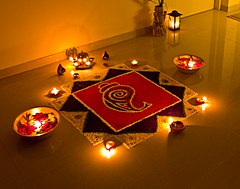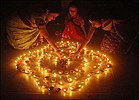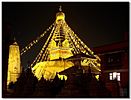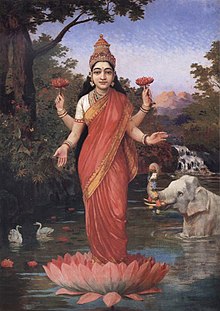Diwali (Deepavali) - The festival of lights and happiness:
Diwali or Deepavali is the Hindu festival of lights celebrated every year in autumn in the northern hemisphere (spring in southern hemisphere). It is an official holiday inIndia, Pakistan, Malaysia, Mauritius, Myanm mlNepal, Singapore, SriLanka, Suriname, Fiji, Gnñbyana and Trinidad and T obago. One of the major festivals of Hinduism, it spiritually signifies the victory of light over darkness, good over evil, knowledge over ignorance, and hope over despair. Its celebration includes millions of lights shining on housetops, outside doors and windows, around temples and other buildings in the communities and countries where it is observed. The festival preparations and rituals typically extend over a five-day period, but the main festival night of Diwali coincides with the darkest, new moon night of the Hindu Lunisolar month Kartika in Bikram Sambatcalendar. In the Gregorian calendar, Diwali night falls between mid-October and mid-November.
Before Diwali night, people clean, renovate, and decorate their homes and offices. On Diwali night, people dress up in new clothes or their best outfit, light up diyas (lamps and candles) inside and outside their home, participate in family puja (prayers) typically toLakshmi – the goddess of fertility and prosperity. After puja, fireworks follow, then a family feast including mithai (sweets), and an exchange of gifts between family members and close friends. Deepavali also marks a major shopping period in nations where it
The name of festive days as well as the rituals of Diwali vary significantly among Hindus, based on the region of India. In many parts of India, the festivities start withDhanteras (in Northern and Western part of India), followed by Naraka Chaturdasi on second day, Deepavali on the third day, Diwali Padva dedicated to wife–husband relationship on the fourth day, and festivities end with Bhai Dooj dedicated to sister–brother bond on the fifth day. Dhanterasusually falls eighteen days after Dussehra.
On the same night that Hindus celebrate Diwali, Jains celebrate a festival also called Diwali to mark the attainment of moksha byMahavira, Sikhs celebrate Bandi Chhor Divas to mark the release of Guru Hargobindfrom a Mughal Empire prison, and Newar Buddhists, unlike the majority of Buddhists, celebrate Diwali by worshipping Lakshmi.
Etymology
Diwali (English pronunciation: /dᵻˈwɑːliː/) or Sanskrit dīpāvali means "series of lights", and is derived from दीप dīpa "light, lamp" and आवलि āvali "series, line, row". Diwali is also known as दीपोत्सव dīpotsava "festival of lights".
The holiday is known as dīpavaḷi in Kannada:ದೀಪಾವಳಿ, Malayalam: ദീപാവലി, and Telugu:దీపావళి, dipawoli in Assamese: দীপাৱলী,dipaboli or dipali in Bengali: দীপাবলি/দীপালি,dipābali in Odia: ଦିପାବଳୀ, divālī in Hindi: दिवाली,dīvālī in Punjabi: ਦੀਵਾਲੀ, divāḷi in Gujarati: દિવાળી,Marathi: दिवाळी, and Konkani: दिवाळी, diyārī inSindhi: दियारी, tīpāvaḷi in Tamil: தீபாவளி,Galungan in Balinese and Swanti in Nepali:स्वन्ति or tihar in Nepali: तिहार.
History
Diwali dates back to ancient times in India, as a festival after the summer harvest in the Hindu calendar month of Kartika. The festival is mentioned in Sanskrit texts such as thePadma Purana, the Skanda Purana both completed in second half of 1st millennium AD but believed to have been expanded from a core text from an earlier era. The diyas(lamps) are mentioned in Skanda Purana to symbolically represent parts of sun, the cosmic giver of light and energy to all life, who seasonally transitions in the Hindu calendar month of Kartik.
Hindus in some regions of India associate Diwali with the legend of Yama and Nachiketaon Kartika amavasya (Diwali night). The Nachiketa story about right versus wrong, true wealth versus transient wealth, knowledge versus ignorance is recorded inKatha Upanishad composed in 1st millennium BC.
King Harsha in the 7th century Sanskrit playNagananda mentions Deepavali asDeepapratipadutsava (Deepa = light, pratipada = first day, utsava = festival), where lamps were lit and newly engaged brides and grooms were given gifts. Rajasekhara referred to Deepavali as Dipamalika in his 9th centuryKavyamimamsa, where in he mentions the tradition of homes being whitewashed and oil lamps decorating homes, streets and markets in the night. The Persian traveller and historian Al Biruni, in his 11th century memoir on India, wrote Deepavali being celebrated by Hindus on New Moon day of the month of Kartika.
Significance
Diwali is one of the happiest holidays in India and Nepal with significant preparations. People clean their homes and decorate them for the festivities. Diwali is one of the biggest shopping seasons in India and Nepal; people buy new clothes for themselves and their families, as well as gifts, appliances, kitchen utensils, even expensive items such as cars and gold jewellery. People also buy gifts for family members and friends which typically include sweets, dry fruits, and seasonal specialties depending on regional harvest and customs. It is also the period when children hear ancient stories, legends about battles between good and evil or light and darkness from their parents and elders. Girls and women go shopping and create rangoli and other creative patterns on floors, near doors and walkways. Youth and adults alike help with lighting and preparing forpatakhe (fireworks).
There is significant variation in regional practices and rituals. Depending on the region, prayers are offered before one or more deities, with most common being Lakshmi – the goddess of wealth and prosperity. On Diwali night, fireworks light up the neighborhood skies. Later, family members and invited friends celebrate the night over food and sweets.
Spiritual significance
Diwali is celebrated by Hindus, Jains, and Sikhs and some Buddhists to mark different historical events, stories but they all symbolise the victory of light over darkness, knowledge over ignorance, good over evil, hope over despair.
The mythical stories told for Diwali vary regionally and within the traditions of Hinduism. Yet, they all point to joy and the celebration of Diwali with lights to be a reminder of the importance of knowledge, self inquiry, self-improvement, knowing and seeking the good and the right path. It is a metaphor for resisting evil, for dispelling darkness and for compassion to others. Diwali is the celebration of this inner light over spiritual darkness, of knowledge over ignorance and right over wrong. It is a festive restatement of the Hindu belief that the good ultimately triumphs over evil.
Hinduism
The religious significance of Deepavali varies regionally within India, depending on the school of Hindu philosophy, regional, legends, and beliefs.
Hindus across the world celebrate Diwali in honor of the return of Lord Rama, his wifeSita and his brother Lakshmana from exile of 14 years after Rama defeated Ravana. To honor the return of Lord Rama, Sita and Lakshmana from Lanka and to illuminate their path, villagers light Diyas to celebrate the triumph of good over evil. For some, Diwali also celebrates the return of Pandavasafter 12 years of Vanvas and one year of "Agyatavas" in Mahabharata. Furthermore, Deepavali is linked to the celebration ofLakshmi, who is venerated amongst Hindus as the goddess of wealth and prosperity and is the wife of Lord Vishnu. The 5-day festival of Diwali begins on the day Goddess Lakshmi was born from the churning of cosmic ocean of milk by the Devas (gods) and the Asuras(demons); while the night of Diwali is the day Lakshmi chose Vishnu as her husband and they were married. Along with Lakshmi, devotees make offerings to Ganesha, who symbolizes ethical beginnings and fearless remover of obstacles; Saraswati, who embodies music, literature and learning andKubera, who symbolizes book-keeping, treasury and wealth management. Other Hindus believe that Diwali is the day Vishnu came back to Lakshmi and their abode in theVaikuntha; so those who worship Lakshmi receive the benefit of her good mood, and therefore are blessed with mental, physical and material wellbeing during the year ahead.
Hindus in India's eastern region, such asOdisha and West Bengal, worship the goddess Kali instead of Lakshmi, and call the festival Kali Puja. In India's Braj and north central regions, the god Krishna is recognized. People mark Mount Govardhan, and celebrate legends about Krishna. In other regions, the feast of Govardhan Puja (or Annakoot) is celebrated, with 56 or 108 different cuisines prepared, offered to Krishna, then shared and celebrated by the local community.
In West and certain Northern parts of India, the festival of Diwali marks the start of a new Hindu year.
Sikhism
Main article: Bandi Chhor Divas
Diwali for Sikhs marks the Bandi Chhor Divas, when Guru Har Gobind freed himself and some Hindu Rajahs, from the Gwalior Fort, from the prison of the Mughal emperor,Jahangir, and arrived at the Golden Temple in Amritsar. Ever since then, Sikhs celebrateBandi Choorh Divas, with the annual lighting up of Golden Temple, fireworks and other festivities. In the post-Guru Gobind Singh era,Sarbat Khalsa used to meet on Diwali andBaisakhi to discuss important issues concerning Sikh community.
Jainism
Main article: Diwali (Jainism)
Diwali has special significance in Jainism. Lord Mahavira, the last of the Tirthankar of this era, attained Nirvana on this day atPavapuri on 15 October 527 BCE, on Kartik Krishna Amavasya. According to theKalpasutra by Acharya Bhadrabahu, 3rd century BC, many gods were present there, illuminating the darkness.Therefore, Jains celebrate Diwali as a day of remembering Mahavira. On Diwali morning, Nirvan Ladoo is offered after praying to Lord Mahavira in all Jain temples all across the world. Gautam Gandhar Swami, the chief disciple of Lord Mahavira achieved omniscience(Kevala Gyan) later the same day.
Buddhism
The Newar people in Nepal, who are Buddhist and revere various deities in the Vajrayanatradition, celebrate the festival by worshipping Lakshmi. The Newar Buddhists in Nepalese valleys celebrate the Diwali festival over five days, in the same way and on the same days as the Hindu Diwali-Tihar festival. According to Robinson, this traditional celebration by Buddhists in Nepal, involving Lakshmi and Vishnu during Diwali, reflects the freedom granted in the MahayanaBuddhism tradition to worship any deity.
In Myanmar, a predominantly Theravada Buddhist community, two festival of lights called the Thadingyut Festival and theTazaungdaing festival mark. One occurs before, and another after Diwali but each on full moon. These mark the events in Buddha's life, such as his return from Tavatimsa heaven. Lights decorate home and temples, and people worship at Burmese pagodas.
Diwali prayers
- Prayers
The prayers vary widely by region of India. An example vedic prayer from Brhadaranyaka Upanishad celebrating lights is:
Translation:









No comments:
Post a Comment